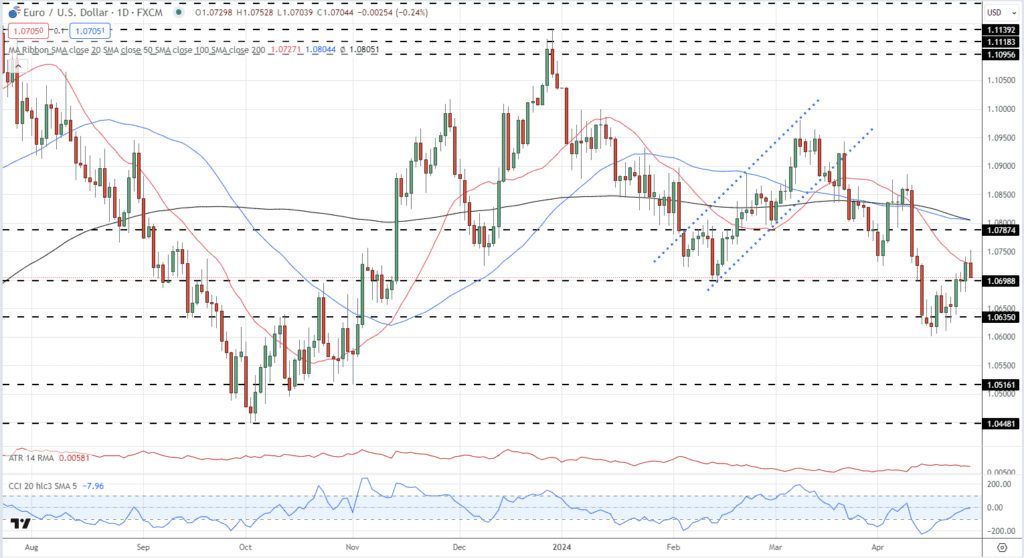The EUR/USD currency pair has recently faced significant volatility. This comes ahead of major economic data releases. These developments are crucial for traders to monitor. They offer insights into possible shifts in the currency values. This week, particular attention centers around the EUR/USD as markets anticipate several key reports.
Impact of Upcoming Economic Data Releases
The focus for the EUR/USD pair remains on the upcoming economic data releases. These include inflation figures and growth data from the Eurozone. Additionally, the U.S. will release its consumer sentiment and ISM manufacturing data. Such releases often drive significant movements in the EUR/USD market. Traders should prepare for potential volatility. These data points provide a snapshot of economic health, influencing the EUR/USD directly.
These economic indicators are critical for assessing the strength of the respective economies. For instance, higher inflation rates in the Eurozone might suggest a heating economy. This could lead to speculation about interest rate hikes. As a result, the EUR could strengthen against the USD. Similarly, robust U.S. consumer sentiment and manufacturing data could signal a strong U.S. economy. This would likely bolster the USD against the EUR.

Moreover, traders analyze these releases to gauge future monetary policy moves. If data from the Eurozone shows economic slowdown, the European Central Bank (ECB) might consider stimulus measures. Such actions generally weaken the currency. Conversely, positive economic data from the U.S. might prompt the Federal Reserve to raise interest rates. This typically strengthens the USD.
Analyzing Market Reactions
Market reactions to these releases can be immediate and dramatic. Traders often position themselves ahead of these announcements. They aim to capitalize on the expected fluctuations in EUR/USD. It is crucial, therefore, to stay updated with these economic calendars. This allows traders to anticipate and respond swiftly to market-moving data.
Furthermore, the timing of these data releases can influence trading strategies. Releases during high market liquidity, such as the opening hours of major markets, might see sharper EUR/USD movements. On the other hand, data released during quieter hours might result in muted reactions.

source:dailyfx
Finally, it is essential for traders to consider other global events when trading EUR/USD around these data releases. Political events, other economic data, or unexpected news can all influence market sentiment. They can either amplify or mitigate the impacts of the scheduled economic releases.
In conclusion, upcoming economic data releases are pivotal for traders focusing on EUR/USD. These indicators not only reflect economic health but also influence currency strength directly. As such, they are watched closely in the forex market.
FOMC Policy Decision: A Crucial Factor
The Federal Open Market Committee (FOMC) policy decision is another pivotal event for the EUR/USD. This decision will likely impact the pair based on the U.S. monetary policy direction. As we’ve seen historically, the FOMC’s stance on interest rates affects the EUR/USD profoundly. A dovish policy may weaken the USD, boosting the EUR/USD pair. Conversely, a hawkish stance could strengthen the USD, applying pressure on EUR/USD.
The anticipation of an FOMC announcement often leads to heightened market volatility. Traders scrutinize every word of the FOMC’s statement. They seek clues about future rate movements. If the FOMC hints at raising interest rates, the USD typically gains strength. As a result, the EUR/USD may face downward pressure. Meanwhile, signals of holding or reducing rates tend to weaken the USD. Consequently, this boosts the EUR/USD exchange rate.
Furthermore, the FOMC’s assessment of economic conditions influences EUR/USD. The Committee evaluates employment levels, inflation rates, and economic growth. These factors guide their interest rate decisions. A positive outlook might suggest upcoming rate hikes. This can fortify the USD against the EUR. Conversely, concerns over economic performance may lead to a more cautious stance. Thus, potentially benefiting the EUR against the USD.
Market Strategies Around FOMC Announcements
Traders often adjust their strategies around FOMC announcements to manage risks or capitalize on expected movements. They might increase their holdings in USD if they anticipate a hawkish outcome. Alternatively, they might favor the EUR if a dovish result seems likely. Moreover, many traders prefer to reduce their positions before the announcement. This minimizes exposure to unexpected market swings.
Additionally, the impact of FOMC decisions extends beyond immediate reactions. Long-term trends in the EUR/USD can also shift based on the perceived trajectory of U.S. monetary policy. As such, staying informed about FOMC policies is crucial for those trading in this currency pair.
In conclusion, the FOMC policy decision plays a critical role in shaping the EUR/USD dynamics. Traders must closely follow these events. They provide significant indicators of future monetary policy and economic health. These, in turn, directly influence the strength and movements of the EUR/USD pair in the forex market.
Interest Rate Differential and Its Influence
The interest rate differential between the Eurozone and the U.S. is a significant factor for EUR/USD. This differential influences investor decisions regarding currency investments. A widening differential, with the U.S. rates climbing relative to the Eurozone’s, typically strengthens the USD against the EUR. On the other hand, if the differential narrows, the EUR could gain strength against the USD.
Moreover, the interest rate spread reflects the relative attractiveness of each currency. When the U.S. offers higher interest rates, investors seek higher returns. Consequently, they may demand more USD, increasing its value. Conversely, lower interest rates in the Eurozone may lead to decreased demand for the EUR. This can weaken its value against the USD.
Furthermore, central bank policies play a crucial role in shaping interest rate differentials. The Federal Reserve and the European Central Bank set monetary policies to achieve economic goals. If the Fed raises rates to curb inflation, it may attract more investors to the USD. This can drive up its value compared to the EUR. Conversely, if the ECB lowers rates to stimulate growth, it may weaken the EUR against the USD.
Implications for Forex Traders
For forex traders, understanding interest rate differentials is essential for formulating trading strategies. Traders may adopt a carry trade strategy when there’s a significant interest rate differential. They borrow funds in a low-interest-rate currency (e.g., EUR) to invest in a higher-yielding currency (e.g., USD). This can result in profit if the higher-yielding currency appreciates against the lower-yielding one.
Additionally, traders closely monitor central bank meetings and economic indicators for hints about future interest rate changes. Speculation about rate hikes or cuts can cause significant fluctuations in the EUR/USD exchange rate. Therefore, staying informed about central bank policies and economic data releases is crucial for successful trading in the forex market.
In summary, the interest rate differential between the Eurozone and the U.S. is a key determinant of EUR/USD exchange rate movements. Changes in this spread can have profound effects on currency values and investor sentiment. Traders must carefully analyze interest rate differentials and their implications for devising effective trading strategies in the forex market.
EUR/GBP Comparison and Correlation
Turning to the EUR/GBP, we observe that movements in this pair can also impact EUR/USD. Often, shifts in EUR/GBP provide indirect clues about EUR/USD trends. For instance, strength in EUR/GBP might suggest broader Euro strength, potentially supporting EUR/USD as well. This week, traders should watch both pairs for correlated movements or diverging trends.

source:dailyfx
Furthermore, the EUR/GBP exchange rate reflects the relative strength of the Euro and the British Pound. If the Euro strengthens against the Pound, it may also gain strength against the USD. Conversely, if the Pound strengthens against the Euro, it may weaken against the USD.
Moreover, traders use the EUR/GBP correlation as a gauge of market sentiment towards the Euro. If EUR/GBP rises, indicating Euro strength, traders might expect similar movements in EUR/USD. However, if EUR/GBP falls, signaling Euro weakness, traders might anticipate downward pressure on EUR/USD.
Implications for Forex Trading
Understanding the correlation between EUR/GBP and EUR/USD is essential for forex traders. By monitoring both pairs, traders can gain insights into potential EUR/USD movements. If EUR/GBP and EUR/USD show diverging trends, traders might consider the factors driving these discrepancies. This can help identify trading opportunities based on misalignments in currency values.
Additionally, traders should be aware of any fundamental factors affecting both currency pairs simultaneously. Economic data releases, central bank announcements, or geopolitical events can impact both EUR/GBP and EUR/USD. By staying informed about these developments, traders can make more informed trading decisions.
In summary, the correlation between EUR/GBP and EUR/USD is a crucial aspect of forex trading. Traders must analyze both pairs to gain a comprehensive understanding of Euro strength or weakness. By monitoring correlated movements and identifying divergences, traders can capitalize on opportunities in the forex market.
Preparing for Volatility: Strategy and Outlook
As economic data releases approach, and the FOMC policy decision looms, EUR/USD traders must strategize. Monitoring these factors closely will be key. Given the potential for increased volatility, having a clear trading strategy is essential. This strategy should consider the impact of interest rate differentials and FOMC policy shifts.
Additionally, traders should diversify their portfolios to mitigate risks associated with heightened volatility. This might involve allocating funds to multiple currency pairs or incorporating hedging strategies. By spreading risk across different assets, traders can better withstand sudden market fluctuations.
Moreover, traders must remain flexible and adaptable in their approach to trading EUR/USD. Economic data releases and central bank decisions can lead to unexpected market movements. Traders should be prepared to adjust their strategies accordingly based on new information and market developments.
Utilizing Risk Management Techniques
Effective risk management is crucial when trading in volatile markets. Traders should set stop-loss orders to limit potential losses and protect their capital. Additionally, implementing proper position sizing techniques can help minimize the impact of adverse market movements.
Furthermore, traders should stay disciplined and avoid making impulsive decisions during periods of high volatility. Emotional trading can lead to irrational behavior and costly mistakes. By adhering to a well-defined trading plan, traders can maintain consistency and avoid succumbing to market pressures.
In conclusion, preparing for volatility in the EUR/USD market requires careful planning and risk management. Traders must develop robust strategies that account for potential fluctuations in economic data and central bank policies. By staying informed, remaining flexible, and employing effective risk management techniques, traders can navigate volatile market conditions with confidence.
Conclusion: Navigating the EUR/USD Landscape
In conclusion, the EUR/USD faces a week filled with crucial data and policy decisions. These elements are likely to shape the currency pair’s path. Traders should focus on the FOMC policy decision and interest rate differentials. These will be particularly influential. By staying informed and prepared, traders can navigate the complexities of the EUR/USD market effectively, capitalizing on opportunities that arise from economic shifts and policy updates.
Click here to read our latest article on Inflation Concerns

